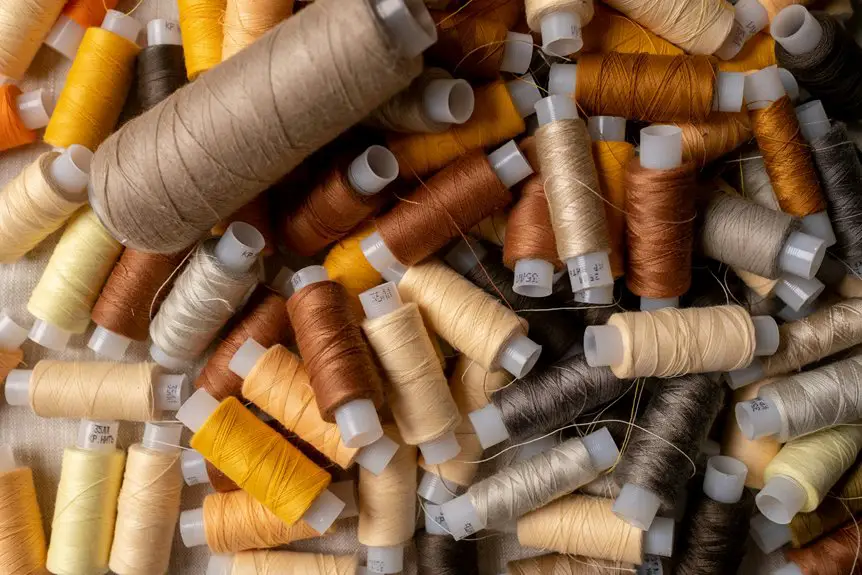You want fabrics that wick moisture, you want comfort that lasts, and you want durability you can trust. When it comes to nylon, polyester, and other synthetics, the differences might not be as straightforward as you think. Each material handles sweat and breathability in unique ways, impacting your performance and comfort. Understanding these nuances can help you make smarter choices for your activewear wardrobe.
Table of Contents
Key Takeaways
- Nylon fibers can be engineered for moisture-wicking but naturally absorb more moisture than polyester, potentially affecting drying speed.
- Polyester’s hydrophobic nature enables faster drying and better moisture management during intense physical activities.
- Nylon offers superior softness and abrasion resistance compared to polyester and other synthetics like polypropylene or acrylic.
- Blending nylon with polyester or spandex enhances moisture-wicking, breathability, elasticity, and overall fabric performance.
- Polyester resists oil and water stains better and withstands stronger cleaning methods than nylon, which may require gentler care.
Understanding Nylon’s Moisture-Wicking Characteristics
Although nylon isn’t naturally moisture-wicking, its synthetic fibers can be engineered to pull sweat away from your skin effectively.
Nylon fibers have a smooth surface that resists moisture retention better than many natural fabrics, helping sweat move quickly from your body to the fabric’s outer layer. This prevents the uncomfortable, clammy feeling you get with high moisture retention.
Nylon’s smooth fibers help sweat move to the fabric’s surface, reducing clamminess and moisture buildup.
When nylon fibers are treated or combined with special finishes, they enhance this moisture transfer, keeping you dry during intense activities.
However, without these treatments, nylon can hold onto moisture longer than you might expect.
Understanding how nylon fibers interact with moisture helps you choose the right gear for your needs and avoid surprises in performance during workouts or outdoor adventures.
Polyester’s Advantages in Moisture Management
When you need reliable moisture management, polyester often outperforms other fabrics thanks to its unique fiber structure. Its hydrophobic nature limits moisture absorption, so sweat doesn’t cling to your skin. This means it dries faster, keeping you comfortable during intense activities.
Here’s why polyester stands out:
- Low moisture absorption prevents sogginess
- High drying speed promotes quick evaporation
- Durable fibers maintain performance wash after wash
- Lightweight fabric reduces overall garment weight
- Resistant to shrinking and stretching for consistent fit
With these advantages, polyester efficiently moves moisture away and dries quickly. You’ll stay dryer and more comfortable, making it a top choice for activewear and outdoor gear focused on moisture management.
Comparing Breathability and Airflow of Nylon and Polyester
You’ll notice that nylon and polyester differ in how much air they let through, which affects how breathable each fabric feels.
Understanding their permeability helps you see how airflow influences your cooling during activity.
Let’s compare these factors to find out which material works best for keeping you comfortable.
Nylon vs. Polyester Permeability
Because both nylon and polyester play major roles in activewear, understanding their permeability can help you choose the best fabric for breathability and airflow.
Nylon permeability tends to be slightly higher than polyester permeability, allowing more moisture vapor to pass through. However, polyester often dries faster due to its hydrophobic nature.
When comparing nylon and polyester permeability, consider these factors:
- Nylon absorbs more moisture, which can affect breathability.
- Polyester’s tighter weave can limit airflow but enhances durability.
- Both fabrics can be engineered for varied permeability.
- Nylon’s permeability supports comfort in moderate activity.
- Polyester’s quick-drying feature benefits intense workouts.
Airflow Impact on Cooling
Although both nylon and polyester offer breathability, their airflow characteristics influence how effectively they cool your body during activity. Nylon’s tighter weave can restrict airflow dynamics slightly, reducing cooling efficiency compared to polyester. Polyester’s more open knit allows better air circulation, helping sweat evaporate faster and keeping you cooler.
| Fabric | Airflow Dynamics |
|---|---|
| Nylon | Moderate, less open |
| Polyester | High, more porous knit |
When you pick polyester, expect enhanced airflow that boosts cooling efficiency during intense workouts. Nylon, while durable, may trap heat more, so it’s better for cooler conditions or lower-intensity activities. Understanding these airflow differences helps you choose the right fabric for your needs, optimizing comfort and performance.
Stain Resistance and Cleaning: Nylon vs. Polyester
When it comes to stains, you’ll find nylon and polyester handle them differently.
Nylon tends to resist stains better but may require gentler cleaning, while polyester cleans up easily but can hold onto certain spots.
Understanding these differences helps you keep your gear looking fresh with the right care.
Stain Resistance Comparison
How well do nylon and polyester stand up to stains? When considering stain resistance and cleaning efficiency, both materials perform differently under everyday conditions.
Polyester generally resists stains better thanks to its hydrophobic nature, which repels water-based spills more effectively than nylon. However, nylon’s slightly porous surface can absorb stains easier, making quick cleaning essential.
Here’s what you need to know:
- Polyester resists oil and water stains better than nylon
- Nylon may hold onto dirt longer, affecting stain removal
- Both fabrics require prompt cleaning to maintain appearance
- Polyester often cleans more efficiently with less residue
- Nylon’s stain resistance can vary by weave and finish
Understanding these differences helps you choose the right fabric for your stain-resistance needs.
Cleaning and Maintenance Differences
Because nylon tends to absorb stains more readily than polyester, you’ll need to act quickly when cleaning nylon fabrics to prevent permanent marks.
When it comes to cleaning techniques, nylon often requires gentler handling; use mild detergents and cold water to avoid damaging fibers.
Polyester, on the other hand, is more resilient and can tolerate warmer water and stronger detergents, making stain removal easier.
For maintenance tips, nylon benefits from prompt spot cleaning and air drying to preserve its wicking properties, while polyester handles machine washing and drying well without losing performance.
How Nylon and Polyester Perform Against Other Synthetic Fabrics
Although nylon and polyester are often grouped together, they each offer distinct advantages and drawbacks compared to other synthetic fabrics in moisture-wicking performance.
You’ll find nylon durability stands out, resisting wear and tear better than many synthetics. Polyester elasticity helps it maintain shape and stretch, enhancing comfort during activity.
When you compare them to fabrics like spandex, acrylic, or polypropylene, consider these points:
- Nylon excels in abrasion resistance but can absorb more moisture.
- Polyester dries quickly and retains shape due to its elasticity.
- Spandex offers superior stretch but less wicking ability.
- Acrylic provides warmth but lacks effective moisture management.
- Polypropylene wicks moisture well but isn’t as durable as nylon.
Choosing between them depends on the balance you want between durability, elasticity, and moisture control.
Practical Uses: When to Choose Nylon or Polyester for Athletic Wear
When you’re picking athletic wear, understanding the strengths of nylon and polyester can help you make the best choice for your activity.
If you need gear that stands up to rough use, nylon’s superior fabric durability makes it ideal for outdoor sports or high-impact workouts.
On the other hand, polyester is often more budget-friendly, so if cost considerations are key, it’s a smart pick for everyday training or casual wear.
Nylon also tends to feel softer and offers better abrasion resistance, while polyester dries quickly and maintains shape well.
Think about where and how you’ll use your clothes—choose nylon for rugged conditions and longer-lasting performance, and polyester when you want lightweight, cost-effective, and moisture-wicking options for less intense activities.
Enhancing Wicking Performance Through Fabric Blends
To boost wicking performance, many manufacturers blend nylon with other fibers like polyester or spandex.
Blending nylon with fibers like polyester or spandex enhances moisture-wicking and overall fabric performance.
These fabric combinations enhance wicking efficiency by balancing moisture management, durability, and stretch. When you choose blends, you get the best of both worlds—nylon’s softness and polyester’s quick-drying ability.
Consider these benefits of fabric blends for wicking:
- Improved moisture transfer
- Enhanced breathability
- Increased elasticity for comfort
- Better durability under stress
- Faster drying times
Frequently Asked Questions
What Environmental Impacts Do Nylon and Polyester Fabrics Have?
Choosing between nylon and polyester is like picking your poison—both have sustainability concerns, including high energy use and microplastic pollution. You’ll want to explore advanced recycling methods to lessen their environmental footprint.
How Do Nylon and Polyester Compare in Terms of Durability Over Time?
You’ll find nylon longevity impressive as it resists abrasion well, but polyester resilience shines in UV exposure and moisture. Both last long, but polyester often outperforms nylon when exposed to sunlight and repeated washing over time.
Are There Cost Differences Between High-Quality Nylon and Polyester Fabrics?
When choosing fabrics, think of nylon pricing like a luxury ticket—often pricier but durable. Polyester value plays the budget-friendly hero, giving you solid performance without breaking the bank. You’ll find each suits different needs perfectly.
Can Nylon or Polyester Cause Skin Irritation or Allergies?
You might experience skin sensitivity or fabric allergies with nylon or polyester, especially if you have sensitive skin. Choosing softer, high-quality fabrics and washing new clothes before wearing can help reduce irritation risks.
What Innovations Are Improving Nylon’S Moisture-Wicking Abilities?
You know what they say, “necessity is the mother of invention.” With nano coating technology and advanced moisture management techniques, you’ll find nylon wicks sweat faster and keeps you drier than ever before—perfect for active wear.
- How to Handle Suede Fabric With a Directional Nap - July 13, 2025
- Can You Use Fabric Dye on Suede Boots? A Guide - July 13, 2025
- How to Make Fabric Patterns Permanent on Suede - July 13, 2025







